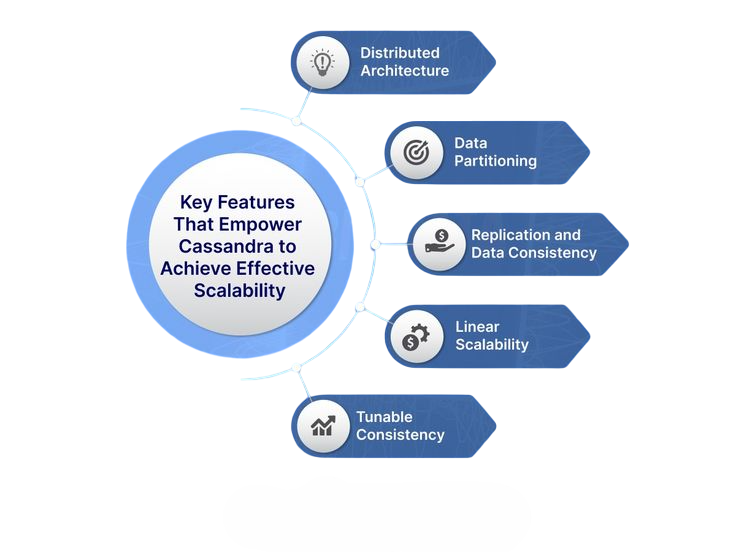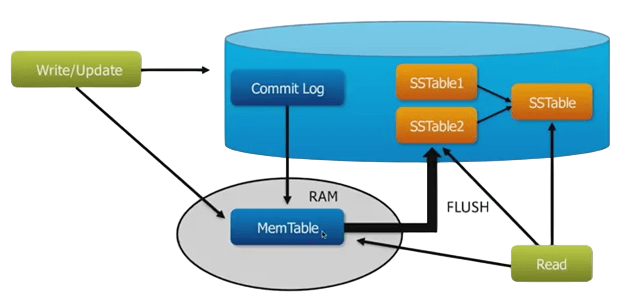
- Introduction
- How Cassandra Empowers Enterprises
- Use Cases in Different Industries
- Understanding Cassandra Architecture
- Data Distribution and Replication
- Hands-On Data Management
- Real-Time Application Scenarios
- Scalability and Performance Benefits
- Conclusion
Introduction
Apache Cassandra is a 100% open-source distributed NoSQL database originally developed at Facebook and maintained by the Apache Software Foundation. Designed from the ground up for high availability and partition tolerance, Cassandra supports multi-data‑center deployments, linear scalability, and tunable consistency. It is optimized for high write workloads and designed to never have a single point of failure. Cassandra’s flexible schema, fault-tolerant architecture, and open-source nature (no licensing constraints) make it ideal for modern, high-scale enterprise systems. In an era where real-time insights drive innovation and impact across domains like IoT, e‑commerce, and fintech, Data Science Training organizations rely on databases that offer unmatched scalability, reliability, and resilience. Apache Cassandra, a distributed, peer-to-peer NoSQL database, has emerged as a foundational technology enabling enterprise workloads that require massive scale, global availability, and low latency. By mastering Cassandra through structured online training, you can become a change agent architecting systems that empower companies to serve millions of users, ingest billions of events, and remain fault-tolerant under the most demanding conditions. This guide explores how Cassandra empowers enterprises, its architecture, benefits, use cases, training modules, career impact, and certification strategy.
How Cassandra Empowers Enterprises
Enterprises looking to build systems that serve global users, operate at scale, and remain resilient under failures turn to Cassandra because of its core strengths. With multi-region replication, data stored in one region is available in others immediately, reducing latency and improving disaster recovery Scala Certification .

Its peer-to-peer architecture ensures every node can accept reads and writes; there is no master node and thus no single point of failure. Operational workloads continue even under node outages, and cluster maintenance can proceed without downtime. Cassandra’s ability to handle massive write throughput with low latency, support flexible schema changes,Application Scenarios and enable near-linear scaling by adding nodes makes it an invaluable asset for enterprises powering real-time systems.
Interested in Obtaining Your Data Science Certificate? View The Data Science Online Training Offered By ACTE Right Now!
Use Cases in Different Industries
Cassandra is employed across a wide range of industries, powering critical use cases:
- Retail & E-commerce: Companies like Best Buy leverage Cassandra to manage catalog and inventory systems that must handle millions of reads and writes during traffic spikes (e.g. holiday events with >50,000 requests per second).
- Streaming & Messaging: Ably Realtime uses Cassandra for persistent message storage at internet scale.
- Internet and Social Media: Major players like Apple, Instagram, Uber, Spotify, Twitter, and eBay use Cassandra to support user activity tracking, Data Architect Salary session storage, and recommendation engines under high availability demands.
- IoT & Monitoring: Companies collect sensor telemetry, clickstream data, and time-series metrics in Cassandra due to its write efficiency and scalability to millions of operations per second.
- Fraud Detection & Real-Time Analytics: Organizations employ Cassandra to support low-latency lookup systems and feature stores in ML pipelines.
These use cases reflect how Cassandra enables operational efficiency, uptime, and data integrity for enterprise-grade applications.
To Explore Data Science in Depth, Check Out Our Comprehensive Data Science Online Training To Gain Insights From Our Experts!
Understanding Cassandra Architecture
At its core, Cassandra is built with a masterless peer-to-peer architecture: all nodes in a cluster are identical and can process client requests. They communicate via a gossip protocol, sharing information about cluster state, schema versions, and availability Data Science Training. The system uses the Phi Accrual Failure Detector to detect node failures, while hinted handoff ensures writes are not lost even if some nodes are temporarily unreachable.

Data is partitioned using consistent hashing, and each partition is replicated according to a replication strategy defined in the keyspace. When adding new nodes to the cluster, Cassandra rebalances data while maintaining continuous availability. Through the commit log, memtable, and SSTable write path (using an LSM-tree model), Cassandra ensures high durability and fast writes. Reads involve checking memtables and SSTables, guided by bloom filters to avoid unnecessary disk I/O.
Data Distribution and Replication
Cassandra’s consistent hashing mechanism ensures even data distribution across cluster nodes. Each node is assigned token ranges, and writes are routed based on partition key hashes leading to balanced workload distribution. Configurable replication factor settings allow data to be copied across multiple nodes and data centers, offering resilience and reduced latency for globally distributed users Apache Spark Certification. When a node goes offline, its replicas serve reads; once it’s back, hinted handoff and repairs reconcile missing writes automatically. High fault tolerance is inherent: if a node or entire data center fails, other replicas seamlessly continue serving traffic making the system highly available even under failure conditions. Enterprises with global presence use this to minimize downtime and optimize customer experiences worldwide.
Gain Your Master’s Certification in Data Science Training by Enrolling in Our Data Science Master Program Training Course Now!
Hands-On Data Management
A structured Cassandra training program emphasizes hands-on cluster operations. Participants build a multi-node Cassandra cluster, configure replication across data centers, and perform failover and recovery drills. Key learning includes creating and modifying keyspaces and tables, tuning write and read consistency levels, and understanding performance implications of compaction strategies An ETL Audit Process and tombstone management. Monitoring through nodetool and JMX metrics helps analyze latency, Data Distribution , disk usage, compaction overhead, and node health. Labs include data modeling projects such as designing tables for catalog systems, time-series ingestion, and user session lookup optimized for real-time workflows.
Real-Time Application Scenarios
In hands-on labs, students simulate real-time scenarios such as:
- An IoT ingestion pipeline using Cassandra to store sensor data arriving via Kafka or MQTT.
- A user activity or session tracking system that logs actions and enables sub-second retrieval.
- A real-time feature store for machine learning: exposing precomputed features stored in Cassandra for low-latency inference in production systems Kafka vs RabbitMQ .
These exercises illustrate how Cassandra supports operational workloads with high throughput and low-latency query response capabilities essential for real-time analytics and reactive applications.
Are You Preparing for Data Science Jobs? Check Out ACTE’s Data Science Interview Questions and Answers to Boost Your Preparation!
Scalability and Performance Benefits
Cassandra boasts linear scalability: doubling the number of nodes typically doubles both read and write capacity, with no downtime required. This makes it ideal for businesses expecting growth or traffic bursts. Cassandra’s high availability and fault tolerance design Dedup : Splunk Documentation coupled with multi-region replication ensures continuous service even during partial system outages. Performance-wise, Cassandra is optimized for write-heavy workloads: append-only writes are durable and fast, while reads use bloom filters and caching to minimize disk access. Tunable consistency, from ONE (fastest) to ALL (strongest), gives teams flexibility in balancing latency and data accuracy. While Cassandra doesn’t support relational joins or complex aggregations, it excels in workloads where lookup speed and scale matter most.
Conclusion
Apache Cassandra empowers enterprises to build globally distributed, real-time data systems with unmatched scalability, availability, and resilience. Its decentralized architecture alongside linear scalability, tunable consistency, and flexible schema design makes it a top choice for mission-critical applications. Through well-structured online training that combines theory, Application Scenarios, hands-on labs, and certification Data Science Training prep, individuals can gain the expertise to design and operate Cassandra Architecture clusters confidently. Whether building IoT pipelines, real-time user tracking systems,Data Distribution , feature stores, or global catalog services, Cassandra enables systems that drive business transformation. By mastering Cassandra, you become a catalyst for change helping organizations move beyond limitations of traditional databases and succeed in a data-driven world.


